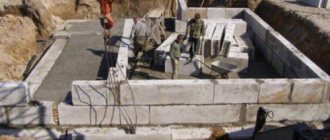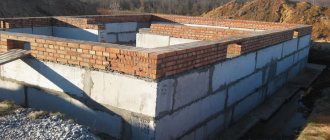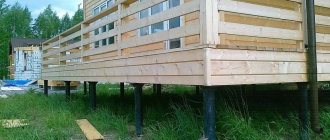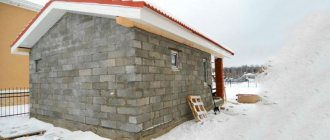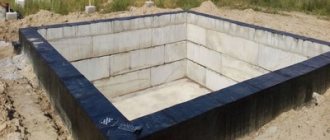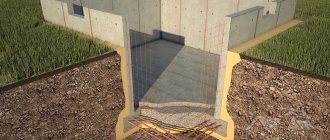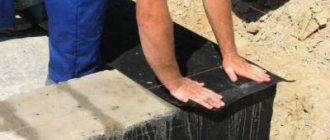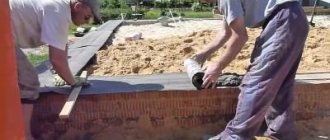The durability and reliability of reinforced concrete wall blocks largely determine their widespread use in the construction of strip foundations. Work on laying finished products significantly reduces construction time, allowing you to eliminate the labor-intensive processes of constructing a reinforcing frame, formwork, as well as preparing and pouring concrete mortar. In addition, their installation can be carried out regardless of weather conditions.
FBS blocks must be carefully isolated from the destructive effects of moisture contained in the soil. The hygroscopicity of unprotected concrete leads to corrosion of the material itself and the metal reinforcement embedded in it, which over time leads to a loss of strength and destruction of the load-bearing foundation of the structure.
Why use foundation waterproofing?
Foundation waterproofing
For those who are thinking for the first time about whether it is necessary to do waterproofing, we will answer right away - of course, it is necessary. After all, we are talking about protecting the surface of the supporting structure. This is almost always a basement wall or basement wall. One of the building materials that is used for protection is aerated concrete. Waterproofing of aerated concrete most often occurs on FSB blocks.
There are two types of waterproofing:
- vertical;
- horizontal.
The vertical type requires a lot of work, but the result is worth it. They start from laying the foundation, to those places where rain or other water waste may leak. The entire foundation row is cleaned of various types of protrusions and chips. All seams are cleaned and sealed.
In the horizontal type, everything is much simpler. Waterproofing of aerated concrete blocks occurs through the application of layers consisting of roofing felt sheets, which are made of bitumen. They are folded step by step into balls. Such balls of roofing material act as a shield to prevent any moisture from penetrating to the surface of the foundation block.
It is necessary to waterproof surfaces in the middle of the structure and on the surface. All work must be done at the same temperature balance, preferably at least 5 degrees.
And in this case, there is a need to clean all the protrusions, remove dirt, chips, and also seal the seams, treat everything with cement. Sometimes they use the method of applying liquid glass to the surface, which makes it possible to maintain the durability of the structure a little longer. And although this method is labor-intensive and expensive, its results are worth it.
What calculations are needed?
In order for waterproofing to be carried out as efficiently as possible, it is necessary to make preliminary calculations even before installing the base itself. These calculations include the following:
- identifying at what level groundwater occurs;
- what level of soil swelling is observed at the construction site;
- what is the heterogeneity of the soil;
- what operating conditions for the entire structure are planned.
FBS combined waterproofing scheme.
These calculations will determine which type of waterproofing should be selected. If the groundwater level is 90 cm below the base of the foundation, then you can get by with a type of insulation such as vertical coating. If it is higher, then horizontal waterproofing is used, the pasting method is suitable.
The combined method for water protection is rarely used; it requires large financial costs . But if calculations show that it is he who should use it, then you should not save. This part of the work is carried out only by experienced specialists; they can be carried out independently only if you have the appropriate experience.
Variations with waterproofing work
Waterproofing work
One of the waterproofing layer options is applied to the foundation block:
- plaster layer;
- pasting layer;
- coating layer.
Type of plaster layer: this composition contains a part of cement mortar with several layers, to which certain additives are added - ceresite, any version of liquid glass, sodium aluminate. The foundation wall is protected from any wet penetration of aerated concrete blocks. Apply several times and only when hot.
Type of adhesive layer: budget option. It is also not labor-intensive. Waterproof material made of polymer-bitumen composition. Protects against moisture, both capillary and filtration. One of the simplest ways to waterproof aerated concrete blocks. The components are heated on the burner.
Having received the hot state of the composition, it is applied to the external foundation. Sometimes, when waterproofing adhesive type, materials with a dark-skinned surface are used. Then there is no need to heat the material.
Materials with a darkening surface:
- roofing felt;
- hydroisol;
- brizol;
- isol.
Ruberoid is used in the surface layers of the foundation roof. Waterproofing material is used around the perimeter. The waterproofing agent contains fiberglass material, which prevents the possibility of destruction due to the influence of fungi and rot.
Foundation waterproofing
One type of insulation is vertical insulation of foundation blocks. One of the most technologically difficult, but effective, injection waterproofing, increases the level of moisture resistance of the foundation material. Waterproofing by injection consists of filling microcracks, seams, and holes with a special compound under pressure.
This method of performing work requires quite a lot of resources and rare, expensive equipment. But the high cost is covered by durability.
Waterproofing foundations consisting of FSB blocks consists of the following steps:
- the seams of the blocks are embroidered to a depth of 50mm;
- a drill is used to divide holes in increments of 20 cm, reaching 75% of the wall thickness;
- parkers for injections are installed;
- a special modified polymer is poured;
- the procedure is performed with a pump for this type of work;
- parkers are removed;
- the holes are sealed flush;
- Coating water-repellent insulation of foundation walls is produced.
The second method is to carry out waterproofing work using the Penetron mixture.
Water-repellent treatment of the base is carried out as follows:
- clean the plaster layer from the walls using a chipper, a hammer drill, or a stiff wire brush;
- Concrete walls are cleaned of tile residues, dirt, paint layers, grease stains, oil - nothing should interfere with the adhesion of the mixture to the wall. If we have polished surfaces, we etch them with a weak acid solution for an hour and a half and then wash them with water.
- floors in basements and basements are being dismantled.
Might be interesting
Waterproofing
How to choose the right floor waterproofing for screed?
Waterproofing
Foundation waterproofing: optimal choice of technology
Waterproofing
Clean water is the key to health, waterproofing concrete…
Waterproofing
Instructions for waterproofing a swimming pool
Then the floor must be strengthened horizontally, for which a reinforcement network is used. The ends of the mesh are connected with reinforcement ties.
After strengthening the mesh on a horizontal surface, the structure is filled with a pre-prepared sand-cement mortar to which crushed stone is added.
Preparatory work for waterproofing
Preparatory work for waterproofing
Preparatory work for waterproofing consists of the following steps:
- removing the cement mixture from the joints of the brickwork material;
- areas of possible leaks are sealed with a quick-setting sealant from Penelag, which hardens very quickly. To prepare Penelag you need:
- dry mix Penelag;
- water.
The mixture is combined with water in a ratio of 0.15 liters of water per 1 kg of mixture. The temperature of the mixture should not be less than 20 degrees Celsius.
Step by step mixing:
- The mixture is thoroughly mixed to a paste-like mass, smooth, uniform consistency.
- Due to the fact that the mixture hardens quickly, there is no need to prepare a large amount at once. The time for using the solution does not exceed 30 seconds before setting.
- Then all connecting surfaces are treated with an additional penetrating waterproofing material, Penetron. The material is applied with a wide brush or brush.
- Then the dry Penecrit mixture is diluted.
- To do this, prepare identical containers with measuring marks and a clean plastic container in advance.
- For mixing, use a drill or construction mixer.
- If small volumes are mixed, mixing is done by hand with obligatory hand protection with rubberized gloves.
How to choose FBS
When building a monolithic basement floor, it is necessary to choose the right grade of concrete. When choosing blocks for the plinth, there is no need to worry about this. But this does not mean that you can purchase any building material offered.
As in the case of foam concrete, the first thing you need to do is make sure that the purchased FBS is of a sufficient level of quality. This can be guaranteed by a passport, which every seller must have. It should contain the following information:
- manufacturer;
- batch number;
- brand;
- weight;
- block dimensions;
- production time;
- level of frost resistance;
- compression resistance level;
- moisture resistance;
- operating standards.
The buyer can additionally check the blocks for deviations. To do this, select several pieces at random and measure the dimensions. The deviation should not exceed 6 mm. If it is more, then the product is considered defective. It is worth remembering that not all types of blocks are good for basement floors.
Blocks are selected based on the thickness of the walls. The presence of cladding near the house also plays a role. In the latter case, the FBS basement blocks should be 10 cm wider than the main wall. This will allow the cladding to rest on them. If the walls will not be additionally lined or heavily insulated, then you can take material of the same width as they are. This will not affect the load-bearing capacity.
Attention! You can calculate all the necessary parameters using a special calculator.
Making the mixture
The mixture is prepared at the rate of 200 grams of water per 1000 grams of Penecrit. It is necessary to thoroughly stir the composition until a thick, creamy mass without lumps is obtained. This composition is also prepared in small quantities. It is necessary to strictly maintain the proportions, since the difference between the material is that it achieves plasticity with constant stirring.
The longer the mixing process, the more plastic the composition will be. The period of use of the composition is no more than thirty minutes. The suture grooves between the FBS blocks are treated with special care with this composition.
After finishing the work, the foundation walls are moistened and then covered again with Penetton using a large brush or paint brush. The solution is used to insulate floor surfaces.
Foundation insulation from FBS blocks
Block installation process
Laying FBS should begin from the corner, i.e. in those places where the walls of the building are expected to intersect. The first blocks must be laid on cement mortar. You shouldn’t make the mortar too thick, so 1-1.5 cm will be enough, because in the future you will have to make vertical joints between the blocks. By and large, the technology here is the same as with traditional bricklaying.
Experts note that it is imperative to observe bandaging in the corners of the house. In addition, it is necessary to insulate each horizontal seam with waterproofing materials. If the basement is 10 blocks high, then 10 waterproofing joints will be required. This point should be considered before construction begins.
During the laying process, it is best to use special beacons, with the help of which you can easily set the right direction. Small deviations are allowed, but they should not exceed 1.5 cm per 1000 cm of masonry. When laying, there should not be any voids or gaps left, because even minor cracks will cause the foundation structure to be noticeably weakened.
Other types of insulation
In addition to expensive injection insulation, you can use coating or cut-off horizontal insulation to protect foundation blocks.
For coating insulation, hot bitumen or mastics based on it are used. Bitumen, creating a film on the surface, seals pores, cracks, holes in FSB blocks, creating an impenetrable barrier for water.
Insulation of foundation wall blocks is carried out as follows:
- the surface is thoroughly cleaned of dirt, soil, concrete humps;
- carefully isolate the cracks with a solution of cement and sand;
- prime the surface of the walls;
- the first ball of heated bitumen is applied to the dried layer;
- after the first ball of bitumen has completely dried, a second layer is applied with strokes perpendicular to the strokes of the first layer to create a durable coating;
- For proper effect, such a coating should not have a thickness of less than three millimeters in one ball.
Working with hot bitumen is quite dangerous due to its heating to a temperature of at least 120 degrees for work. Hardening takes place very quickly, so it only takes 4-5 minutes to apply to the wall. If it's cold enough outside, working with a hot compound is very inconvenient.
Cold bitumen mastics are much more effective in this case. This mastic contains polymers, which makes it plastic.
The most modern material for coating waterproofing of foundation blocks is penetrating waterproofing with penetrating compounds. The composition is based on cement, quartz dust, and polymer additives. When the mixture is applied to concrete, it gets inside due to capillary suction and crystallizes in the pores of the concrete. As a result, after the mixture dries, we obtain a monolith that is one third stronger than a concrete base. As water tries to penetrate deeper, the concrete becomes even stronger.
Dry penetrating mixtures are sold dry in bags and diluted with water to the consistency of thick sour cream. The composition should be easily applied with a brush or brush. When working, you need to observe a time lag of 30 minutes, since the solution sets quickly. It is strictly prohibited to dilute the solution.
The stages of foundation waterproofing with penetrating insulation look like this
- the foundation is cleared of dirt:
- wall blocks are cleaned of remnants of paint, plaster, and old coatings;
- if the surface of the old foundation coating is glossy, it is treated with acid for several minutes;
- The surface must be damp when applying the waterproofing solution.
The solution is applied manually with a brush or roller in several layers. The full effect of waterproofing with a penetrating mixture is visible after a few days.
